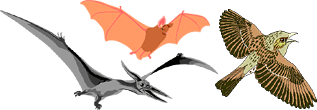Vertebrate Flight
THE THREE SOLUTIONS TO FLIGHT

Possibly the most amazing example of convergent evolution among vertebrates is the evolution of flight in three different taxa. In their similarities, we see indications of common constraints imposed by the phylogeny and the biomechanics of organisms. In their differences, we see how evolution has taken unique routes to comply with these constraints, resulting in different functional patterns. The evolution of flight is a classic example of macroevolution — the fossil record shows that once powered flight is attained, flying lineages tend to evolve quickly and radiate into diverse niches. You might be surprised, but the evolution of flight is, for the most part, well documented with transitional forms. Let's investigate the origin and evolution of flight in our representative taxa: the Pterosauria (pterosaurs), Aves (birds), and Chiroptera (bats).
Note: It is a good idea to review our exhibits on each taxon (links provided in each section) before diving into each example of the evolution of flight. You should also have a firm grasp of the procedure used for determining the origins of flight in a lineage.